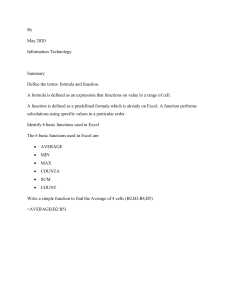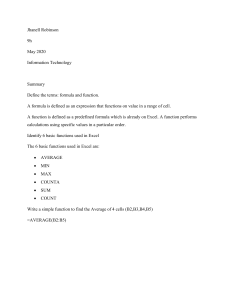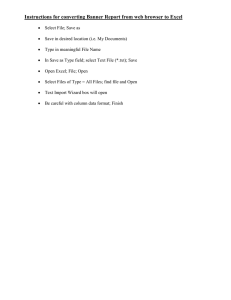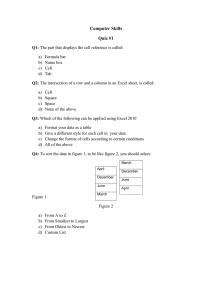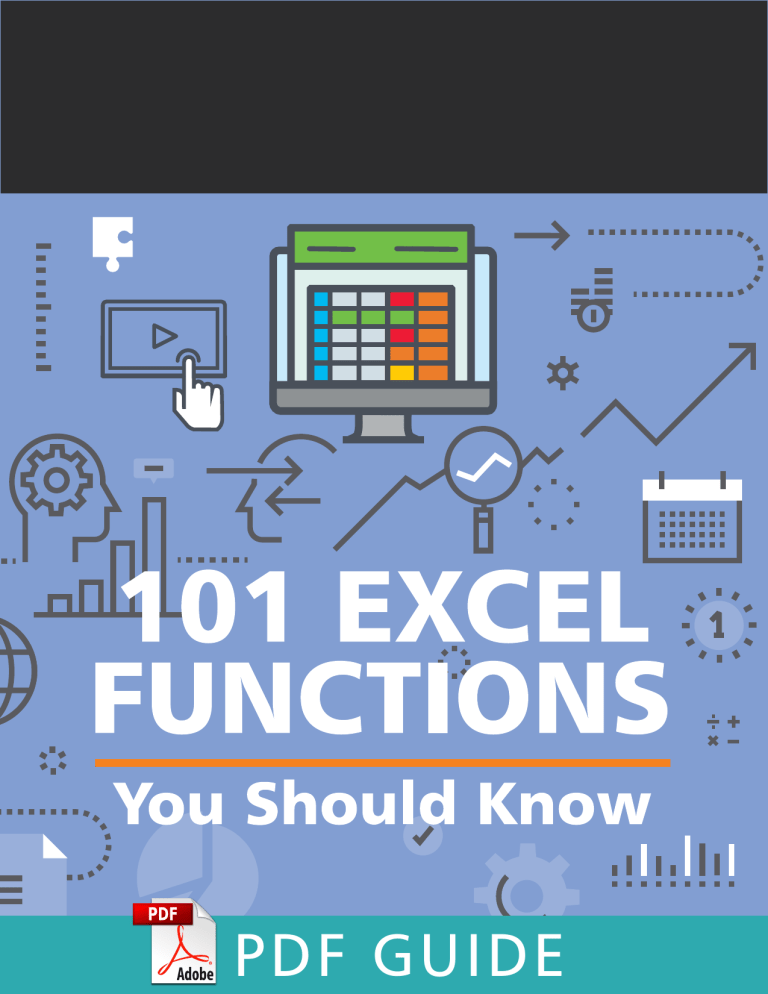
PDF GUIDE Quick Navigation TABLE of Contents 101 Excel Functions���������������������������������������������������������������������������������2 Date and Time Functions�������������������������������������������������������������������������3 Engineering ���������������������������������������������������������������������������������������������9 Information Functions ���������������������������������������������������������������������������10 Logical Functions�����������������������������������������������������������������������������������11 Lookup and Reference Functions �����������������������������������������������������������13 STATISTICAL Functions���������������������������������������������������������������������������19 MATH Functions�������������������������������������������������������������������������������������24 TEXT Functions���������������������������������������������������������������������������������������28 Dynamic Array Functions�����������������������������������������������������������������������33 More Resources�������������������������������������������������������������������������������������34 - ABS AGGREGATE AND AVERAGE AVERAGEIF AVERAGEIFS CEILING CHAR CHOOSE CLEAN CODE COLUMN COLUMNS CONCAT CONCATENATE CONVERT COUNT COUNTA COUNTBLANK COUNTIF COUNTIFS DATE DATEDIF DAY EDATE EOMONTH EXACT FILTER FIND FLOOR GETPIVOTDATA HLOOKUP HOUR HYPERLINK IF IFERROR IFNA IFS INDEX INDIRECT INT ISBLANK ISERROR ISEVEN ISFORMULA ISLOGICAL ISNUMBER ISODD ISTEXT LARGE LEFT LEN LOOKUP LOWER MATCH MAX MAXIFS MID MIN MINIFS MINUTE MOD MODE MONTH MROUND NETWORKDAYS NOT NOW OFFSET OR PROPER RAND RANDARRAY RANDBETWEEN RANK REPLACE RIGHT ROUND ROUNDDOWN ROUNDUP ROW ROWS SEARCH SECOND SEQUENCE SMALL SORT SORTBY SUBSTITUTE SUBTOTAL SUM SUMIF SUMIFS SUMPRODUCT TEXT TEXTJOIN TIME TODAY TRANSPOSE TRIM UNIQUE UPPER VLOOKUP WEEKDAY WEEKNUM WORKDAY XLOOKUP XMATCH YEAR YEARFRAC Table of Contents 101 EXCEL FUNCTIONS 1 101 Excel Functions Excel has over 480 built-in functions, and more are still being added. That is a huge number of functions to think about, even for advanced users. Thankfully, you don’t need to learn all of these functions to be productive in Excel. If you have a basic understanding of about a hundred key functions, you’ll be far ahead of the average user. This document contains a brief overview of about 100 important Excel functions you should know, with links to detailed examples. It is based on a more complete list of Excel functions here. Excel Function List We also have a large list of example formulas and video training. If you are new to Excel formulas and how functions are used, see this introduction. Quick Navigation ABS AGGREGATE AND AVERAGE AVERAGEIF AVERAGEIFS CEILING CHAR CHOOSE CLEAN CODE COLUMN COLUMNS CONCAT CONCATENATE CONVERT COUNT COUNTA COUNTBLANK COUNTIF COUNTIFS DATE DATEDIF DAY EDATE EOMONTH EXACT FILTER FIND FLOOR GETPIVOTDATA HLOOKUP HOUR HYPERLINK IF IFERROR IFNA IFS INDEX INDIRECT INT ISBLANK ISERROR ISEVEN ISFORMULA ISLOGICAL ISNUMBER ISODD ISTEXT LARGE LEFT LEN LOOKUP LOWER MATCH MAX MAXIFS MID MIN MINIFS MINUTE MOD MODE MONTH MROUND NETWORKDAYS NOT NOW OFFSET OR PROPER RAND RANDARRAY RANDBETWEEN RANK REPLACE RIGHT ROUND ROUNDDOWN ROUNDUP ROW ROWS SEARCH SECOND SEQUENCE SMALL SORT SORTBY SUBSTITUTE SUBTOTAL SUM SUMIF SUMIFS SUMPRODUCT TEXT TEXTJOIN TIME TODAY TRANSPOSE TRIM UNIQUE UPPER VLOOKUP WEEKDAY WEEKNUM WORKDAY XLOOKUP XMATCH YEAR YEARFRAC Table of Contents 101 EXCEL FUNCTIONS 2 Date and Time Functions Excel provides many functions to work with dates and times. NOW and TODAY You can get the current date with the TODAY function and the current date and time with the NOW Function. Technically, the NOW function returns the current date and time, but you can format as time only, as seen below: Note: these are volatile functions and will recalculate with every worksheet change. If you want a static value, use date and time shortcuts. Easily add Date and Time to your Excel files using these functions DATE SHORTCUT: This shortcut will insert the current date as a fixed value; it will not change. TIME SHORCUT: This shortcut will insert the current time as a fixed value; it will not change. [Note: In Mac 2016, Control Shift : stopped working to insert a time. Command ; now seems to work.] More excel shortcuts. 101 EXCEL FUNCTIONS 3 DAY, MONTH, YEAR, and DATE You can use the DAY, MONTH, and YEAR functions to disassemble any date into its raw components, and the DATE function to put things back together again. Did you know? Excel dates are serial numbers that start in the year 1900. Excel times are fractions of the number 1. Both dates and times are numbers that can be used in math operations. HOUR, MINUTE, SECOND, and TIME Excel provides a set of parallel functions for times. You can use the HOUR, MINUTE, and SECOND functions to extract pieces of a time, and you can assemble a TIME from individual components with the TIME function. 101 EXCEL FUNCTIONS 4 DATEDIF and YEARFRAC You can use the DATEDIF function to get time between dates in years, months, or days. DATEDIF can also be configured to get total time in “normalized” denominations, i.e. “2 years and 5 months and 27 days”. The DATEDIF function is a good way to calculate age from a birthday. See this example formula. Use YEARFRAC to get fractional years: Quick Navigation ABS AGGREGATE AND AVERAGE AVERAGEIF AVERAGEIFS CEILING CHAR CHOOSE CLEAN CODE COLUMN COLUMNS CONCAT CONCATENATE CONVERT COUNT COUNTA COUNTBLANK COUNTIF COUNTIFS DATE DATEDIF DAY EDATE EOMONTH EXACT FILTER FIND FLOOR GETPIVOTDATA HLOOKUP HOUR HYPERLINK IF IFERROR IFNA IFS INDEX INDIRECT INT ISBLANK ISERROR ISEVEN ISFORMULA ISLOGICAL ISNUMBER ISODD ISTEXT LARGE LEFT LEN LOOKUP LOWER MATCH MAX MAXIFS MID MIN MINIFS MINUTE MOD MODE MONTH MROUND NETWORKDAYS NOT NOW OFFSET OR PROPER RAND RANDARRAY RANDBETWEEN RANK REPLACE RIGHT ROUND ROUNDDOWN ROUNDUP ROW ROWS SEARCH SECOND SEQUENCE SMALL SORT SORTBY SUBSTITUTE SUBTOTAL SUM SUMIF SUMIFS SUMPRODUCT TEXT TEXTJOIN TIME TODAY TRANSPOSE TRIM UNIQUE UPPER VLOOKUP WEEKDAY WEEKNUM WORKDAY XLOOKUP XMATCH YEAR YEARFRAC Table of Contents 101 EXCEL FUNCTIONS 5 EDATE and EOMONTH A common task with dates is to shift a date forward (or backward) by a given number of months. You can use the EDATE and EOMONTH functions for this. EDATE moves by month and retains the day. EOMONTH works the same way, but always returns the last day of the month. Shift dates Forward (or Backward) using EDATE 101 EXCEL FUNCTIONS 6 WORKDAY and NETWORKDAYS To figure out a date n working days in the future, you can use the WORKDAY function. To calculate the number of workdays between two dates, you can use NETWORKDAYS. VIDEO How to calculate due dates with WORKDAY Practice worksheets included with online Video Training Note: Both functions automatically skip weekends (Saturday and Sunday) and will also skip holidays, if provided. If you need more flexibility on what days are considered weekends, see the WORKDAY.INTL function and NETWORKDAYS.INTL function. 101 EXCEL FUNCTIONS 7 WEEKDAY and WEEKNUM To figure out the day of week from a date, Excel provides the WEEKDAY function. WEEKDAY returns a number between 1-7 that indicates Sunday, Monday, Tuesday, etc. Use the WEEKNUM function to get the week number in a given year. See this formula to calculate sales per weekday. FORMULA Get the monday of the week 101 EXCEL FUNCTIONS 8 Engineering CONVERT Most Engineering functions are pretty technical... you’ll find a lot of functions for complex numbers in this section. However, the CONVERT function is quite useful for everyday unit conversions. You can use CONVERT to change units for distance, weight, temperature, and much more. Using the Versatile Convert Function 1 Gallon = 3.8 Litres cm in See this formula to calculate the BMI of an individual where the CONVERT function is used to convert between the metric and imperial unit systems. 101 EXCEL FUNCTIONS 1 in = 2.54 cm 9 Information Functions ISBLANK, ISERROR, ISNUMBER, and ISFORMULA Excel provides many functions for checking the value in a cell, including ISNUMBER, ISTEXT, ISLOGICAL, ISBLANK, ISERROR, and ISFORMULA These functions are sometimes called the “IS” functions, and they all return TRUE or FALSE based on a cell’s contents. True or False results using Information Functions Excel also has ISODD and ISEVEN functions will test a number to see if it’s even or odd. By the way, the green fill in the screenshot above is applied automatically with a conditional formatting formula. 101 EXCEL FUNCTIONS 10 Logical Functions Excel’s logical functions are a key building block of many advanced formulas. Logical functions return the boolean values TRUE or FALSE. If you need a primer on logical formulas, this video goes through many examples. Is it Green? AND, OR and NOT The core of Excel’s logical functions are the AND function, the OR function, and the NOT function. In the screen below, each of these function is used to run a simple test on the values in column B: IF and IFS functions The IF function is one of the most used functions in Excel. In the screen below, IF checks test scores and assigns “pass” or “fail”: VIDEO How to build logical formulas GUIDE 50 examples of formula criteria The logical functions above can be combined with the IF function to create more complex logical tests. Alternatively, multiple IF functions can be nested together to return more than two values as a result. 101 EXCEL FUNCTIONS 11 New in Excel 2019 and Office 365, the IFS function can run multiple logical tests without nesting IFs. IFERROR and IFNA The IFERROR function and IFNA function can be used as a simple way to trap and handle errors. In the screen below, VLOOKUP is used to retrieve cost from a menu item. Column F contains just a VLOOKUP function, with no error handling. Column G shows how to use IFNA with VLOOKUP to display a custom message when an unrecognized item is entered. Whereas IFNA only catches an #N/A error, the IFERROR function will catch any formula error. Quick Navigation ABS AGGREGATE AND AVERAGE AVERAGEIF AVERAGEIFS CEILING CHAR CHOOSE CLEAN CODE COLUMN COLUMNS CONCAT CONCATENATE CONVERT COUNT COUNTA COUNTBLANK COUNTIF COUNTIFS DATE DATEDIF DAY EDATE EOMONTH EXACT FILTER FIND FLOOR GETPIVOTDATA HLOOKUP HOUR HYPERLINK IF IFERROR IFNA IFS INDEX INDIRECT INT ISBLANK ISERROR ISEVEN ISFORMULA ISLOGICAL ISNUMBER ISODD ISTEXT LARGE LEFT LEN LOOKUP LOWER MATCH MAX MAXIFS MID MIN MINIFS MINUTE MOD MODE MONTH MROUND NETWORKDAYS NOT NOW OFFSET OR PROPER RAND RANDARRAY RANDBETWEEN RANK REPLACE RIGHT ROUND ROUNDDOWN ROUNDUP ROW ROWS SEARCH SECOND SEQUENCE SMALL SORT SORTBY SUBSTITUTE SUBTOTAL SUM SUMIF SUMIFS SUMPRODUCT TEXT TEXTJOIN TIME TODAY TRANSPOSE TRIM UNIQUE UPPER VLOOKUP WEEKDAY WEEKNUM WORKDAY XLOOKUP XMATCH YEAR YEARFRAC Table of Contents 101 EXCEL FUNCTIONS 12 Lookup and Reference Functions VLOOKUP and HLOOKUP Excel offers a number of functions to lookup and retrieve data. Most famous of all is VLOOKUP: VLOOKUP is for vertical data HLOOKUP is for horizontal data More: 23 things to know about VLOOKUP. HLOOKUP works like VLOOKUP, but expects data arranged horizontally: VLOOKUP only looks to the Right 101 EXCEL FUNCTIONS 13 INDEX and MATCH For more complicated lookups, INDEX and MATCH offers more flexibility and power: The MATCH function is designed to find the position of an item in a range. Both the INDEX function and the MATCH function are powerhouse functions that turn up in all kinds of formulas. LOOKUP The LOOKUP function has default behaviors that make it useful when solving certain problems. LOOKUP assumes values are sorted in ascending order and always performs an approximate match. When LOOKUP can’t find a match, it will match the next smallest value. In the example below we are using LOOKUP to find the last entry in a column: ARTICLE How to use INDEX and MATCH This page explains this LOOKUP example in more depth. 101 EXCEL FUNCTIONS 14 ROW and COLUMN You can use the ROW function and COLUMN function to find row and column numbers on a worksheet. Notice both ROW and COLUMN return values for the current cell if no reference is supplied: The row function also shows up often in advanced formulas that process data with relative row numbers. ROWS and COLUMNS The ROWS function and COLUMNS function provide a count of rows in a reference. In the screen below, we are counting rows and columns in an Excel Table named “Table1”. Note ROWS returns a count of data rows in a table, excluding the header row. By the way, here are 23 things to know about Excel Tables. Quick Navigation ABS AGGREGATE AND AVERAGE AVERAGEIF AVERAGEIFS CEILING CHAR CHOOSE CLEAN CODE COLUMN COLUMNS CONCAT CONCATENATE CONVERT COUNT COUNTA COUNTBLANK COUNTIF COUNTIFS DATE DATEDIF DAY EDATE EOMONTH EXACT FILTER FIND FLOOR GETPIVOTDATA HLOOKUP HOUR HYPERLINK IF IFERROR IFNA IFS INDEX INDIRECT INT ISBLANK ISERROR ISEVEN ISFORMULA ISLOGICAL ISNUMBER ISODD ISTEXT LARGE LEFT LEN LOOKUP LOWER MATCH MAX MAXIFS MID MIN MINIFS MINUTE MOD MODE MONTH MROUND NETWORKDAYS NOT NOW OFFSET OR PROPER RAND RANDARRAY RANDBETWEEN RANK REPLACE RIGHT ROUND ROUNDDOWN ROUNDUP ROW ROWS SEARCH SECOND SEQUENCE SMALL SORT SORTBY SUBSTITUTE SUBTOTAL SUM SUMIF SUMIFS SUMPRODUCT TEXT TEXTJOIN TIME TODAY TRANSPOSE TRIM UNIQUE UPPER VLOOKUP WEEKDAY WEEKNUM WORKDAY XLOOKUP XMATCH YEAR YEARFRAC Table of Contents 101 EXCEL FUNCTIONS 15 HYPERLINK You can use the HYPERLINK function to construct a link with a formula. Note HYPERLINK lets you build both external links and internal links: Build External and Internal Hyperlinks GETPIVOTDATA The GETPIVOTDATA function is useful for retrieving information from existing pivot tables. 101 EXCEL FUNCTIONS 16 CHOOSE The CHOOSE function is handy any time you need to make a choice based on a number: VIDEO How to use the CHOOSE function TRANSPOSE The TRANSPOSE function gives you an easy way to transpose vertical data to horizontal, and vice versa. Note: TRANSPOSE is a formula and is therefore dynamic. If you just need to do a one-time transpose operation, use Paste Special instead. 101 EXCEL FUNCTIONS Transpose Vertical Data to Horizontal 17 OFFSET The OFFSET function is useful for all kinds of dynamic ranges. From a starting location, it lets you specify row and column offsets, and also the final row and column size. The result is a range that can be respond dynamically to changing conditions and inputs. You can feed this range to other functions, as in the screen below, where OFFSET builds a range that is fed to the SUM function: INDIRECT The INDIRECT function allows you to build references as text. This concept is a bit tricky to understand at first, but it can be useful in many situations. Below, we are using INDIRECT to get values from cell A1 in 5 different worksheets. Each reference is dynamic. If a sheet name changes, the reference will update. The main purpose of OFFSET is to allow formulas to dynamically adjust to available data or to user input. Caution: Both OFFSET and INDIRECT are volatile functions and can slow down large or complicated spreadsheets. The INDIRECT function is also used to “lock” references so they won’t change, when rows or columns are added or deleted. For more details, see linked examples at the bottom of the INDIRECT function page. 101 EXCEL FUNCTIONS 18 STATISTICAL Functions COUNT and COUNTA You can count numbers with the COUNT function and non-empty cells with COUNTA. You can count blank cells with COUNTBLANK, but in the screen below we are counting blank cells with COUNTIF, which is more generally useful. How Many? COUNTIF and COUNTIFS For conditional counts, the COUNTIF function can apply one criteria. The COUNTIFS function can apply multiple criteria at the same time: VIDEO How to use the COUNTIF Function 101 EXCEL FUNCTIONS 19 SUM, SUMIF, SUMIFS To sum everything, use the SUM function. To sum conditionally, use SUMIF or SUMIFS. Following the same pattern as the counting functions, the SUMIF function can apply only one criteria while the SUMIFS function can apply multiple criteria. AVERAGE, AVERAGEIF, and AVERAGEIFS Following the same pattern, you can calculate an average with AVERAGE, AVERAGEIF, and AVERAGEIFS. 101 EXCEL FUNCTIONS 5 9 7 __ 23 VIDEO How to use the SUMIF function 20 MIN, MAX, LARGE, SMALL You can find largest and smallest values with MAX and MIN, and nth largest and smallest values with LARGE and SMALL. In the screen below, “data” is the named range C5:C13, used in all formulas. Find LARGEST and SMALLEST values VIDEO How to find the nth smallest or largest value 101 EXCEL FUNCTIONS 21 MINIFS, MAXIFS The MINIFS and MAXIFS. These functions let you find minimum and maximum values with conditions: Find the smallest blue fish Note: MINIFS and MAXIFS are new in Excel via Office 365 and Excel 2019. MODE The MODE function returns the most commonly occurring number in a range: 101 EXCEL FUNCTIONS Most commonly occuring dog color 22 RANK To rank values largest to smallest, or smallest to largest, use the RANK function: Rank Largest to Smallest See this formula which demonstrates how to use the RANK function to calculate race results. Video How to rank values with the RANK function 101 EXCEL FUNCTIONS 23 MATH Functions ABS To change negative values to positive use the ABS function. ABS — Negative to Positive RAND and RANDBETWEEN Both the RAND function and RANDBETWEEN function can generate random numbers on the fly. RAND creates long decimal numbers between zero and 1. RANDBETWEEN generates random integers between two given numbers. To generate a random dice roll RANDBETWEEN(1,6) 101 EXCEL FUNCTIONS 24 ROUND, ROUNDUP, ROUNDDOWN, INT To round values up or down, use the ROUND function. To force rounding up to a given number of digits, use ROUNDUP. To force rounding down, use ROUNDDOWN. To discard the decimal part of a number altogether, use the INT function. MROUND, CEILING, FLOOR To round values to a the nearest multiple use the MROUND function. The FLOOR function and CEILING function also round to a given multiple. FLOOR forces rounding down, and CEILING forces rounding up. Quick Navigation ABS AGGREGATE AND AVERAGE AVERAGEIF AVERAGEIFS CEILING CHAR CHOOSE CLEAN CODE COLUMN COLUMNS CONCAT CONCATENATE CONVERT COUNT COUNTA COUNTBLANK COUNTIF COUNTIFS DATE DATEDIF DAY EDATE EOMONTH EXACT FILTER FIND FLOOR GETPIVOTDATA HLOOKUP HOUR HYPERLINK IF IFERROR IFNA IFS INDEX INDIRECT INT ISBLANK ISERROR ISEVEN ISFORMULA ISLOGICAL ISNUMBER ISODD ISTEXT LARGE LEFT LEN LOOKUP LOWER MATCH MAX MAXIFS MID MIN MINIFS MINUTE MOD MODE MONTH MROUND NETWORKDAYS NOT NOW OFFSET OR PROPER RAND RANDARRAY RANDBETWEEN RANK REPLACE RIGHT ROUND ROUNDDOWN ROUNDUP ROW ROWS SEARCH SECOND SEQUENCE SMALL SORT SORTBY SUBSTITUTE SUBTOTAL SUM SUMIF SUMIFS SUMPRODUCT TEXT TEXTJOIN TIME TODAY TRANSPOSE TRIM UNIQUE UPPER VLOOKUP WEEKDAY WEEKNUM WORKDAY XLOOKUP XMATCH YEAR YEARFRAC Table of Contents 101 EXCEL FUNCTIONS 25 MOD The MOD function returns the remainder after division. This sounds boring and geeky, but MOD turns up in all kinds of formulas, especially formulas that need to do something “every nth time”. In the screen below, you can see how MOD returns zero every third number when the divisor is 3: The MOD function returns the remainder SUMPRODUCT The SUMPRODUCT function is powerful and versatile tool when dealing with all kinds data. You can use SUMPRODUCT to easily count and sum based on criteria, and you can use it in elegant ways that just don’t work with COUNTIFS and SUMIFS. In the screen below, we are using SUMPRODUCT to count and sum orders in March. See the SUMPRODUCT page for details and links to many examples. Sunglasses sold in July Sumproduct is a powerful and versatile tool that is easy to use. 101 EXCEL FUNCTIONS 26 SUBTOTAL The SUBTOTAL function is an “aggregate function” that can perform a number of operations on a set of data. The key feature of SUBTOTAL is that it will ignore rows that have been “filtered out” of an Excel Table, and, optionally, rows that have been manually hidden. In the screen below, SUBTOTAL is used to count and sum only the 7 visible rows in the table: AGGREGATE Like SUBTOTAL, the AGGREGATE function can run a number of aggregate operations on a set of data and can optionally ignore hidden rows. The key differences are that AGGREGATE can run more operations and can also ignore errors. SUBTOTAL can perform 11 operations, including SUM, AVERAGE, COUNT, MAX, MIN, etc. (see This Page for the full list) AGGREGATE can perform 19 operations and can also ignore errors. See this page for a full list of operations. Above, AGGREGATE is used to perform MIN, MAX, LARGE and SMALL operations while ignoring errors. Normally, the error in cell B9 would prevent these functions from returning a result. 101 EXCEL FUNCTIONS 27 TEXT Functions LEFT, RIGHT, MID To extract characters from the left, right, or middle of text, use LEFT, RIGHT, and MID functions: Separate text into columns FORMULA LEN Get first name from full name The LEN function will return the length of a text string. LEN shows up in a lot of formulas that count words or characters. 101 EXCEL FUNCTIONS 28 FIND, SEARCH To look for specific text in a cell, use the FIND function or SEARCH function. These functions return the numeric position of matching text, but SEARCH allows wildcards and FIND is case-sensitive. Both functions will throw an error when text is not found, so wrap in the ISNUMBER function to return TRUE or FALSE (example here). Text Functions — Find, Replace and Sustitute REPLACE, SUBSTITUTE To replace text by position, use the REPLACE function. To replace text by matching, use the SUBSTITUTE function. In the first example, REPLACE removes the two asterisks (**) by replacing the first two characters with an empty string (“”). In the second example, SUBSTITUTE removes all hash characters (#) by replacing “#” with “”. 101 EXCEL FUNCTIONS FORMULA Cell contains one of many things 29 CODE, CHAR To figure out the numeric code for a character, use the CODE function. To translate the numeric code back to a character, use the CHAR function. In the example below, CODE translates each character in column B to its corresponding code. In column F, CHAR translates the code back to a character. VIDEO How to use the CODE and CHAR functions TRIM, CLEAN To get rid of extra space in text, use the TRIM function. To remove line breaks and other non-printing characters, use CLEAN. VIDEO How to clean text with TRIM and CLEAN 101 EXCEL FUNCTIONS 30 CONCAT, TEXTJOIN, CONCATENATE New in Excel via Office 365 are CONCAT and TEXTJOIN. The CONCAT function lets you concatenate (join) multiple values, including a range of values without a delimiter. The TEXTJOIN function does the same thing, but allows you to specify a delimiter and can also ignore empty values. Join cells together Excel also provides the CONCATENATE function, but it doesn’t offer special features. I would’t bother with it and would instead concatenate directly with the ampersand (&) character in a formula. EXACT The EXACT function allows you to compare two text strings in a casesensitive manner. 101 EXCEL FUNCTIONS 31 UPPER, LOWER, PROPER To change the case of text, use the UPPER, LOWER, and PROPER function Standardize a List of Names TEXT Last but definitely not least is the TEXT function. The text function lets you apply number formatting to numbers (including dates, times, etc.) as text. This is especially useful when you need to embed a formatted number in a message, like “Sale ends on [date]”. VIDEO How to change case with formulas More: Detailed examples of custom number formatting. 101 EXCEL FUNCTIONS 32 Dynamic Array Functions Dynamic arrays are new in Excel 365, and are a major upgrade to Excel’s formula engine. As part of the dynamic array update, Excel includes new functions which directly leverage dynamic arrays to solve problems that are traditionally hard to solve with conventional formulas. If you are using Excel 365, make sure you are aware of these new functions: FILTER and SORT can be used in many ways FUNCTION PURPOSE FILTER . . . . . . . . Filter data and return matching records RANDARRAY . . . Generate array of random numbers SEQUENCE. . . . . Generate array of sequential numbers SORT. . . . . . . . . . Sort range by column SORTBY . . . . . . . Sort range by another range or array UNIQUE . . . . . . . Extract unique values from a list or range XLOOKUP. . . . . . Modern replacement for VLOOKUP XMATCH. . . . . . . Modern replacement for the MATCH function VIDEO New dynamic array functions in Excel (about 3 minutes). 101 EXCEL FUNCTIONS 33 More Resources See also the full list of Excel functions and collection of Excel Formulas on our website for reference. Excel Training In addition to the free resources on the site, we also provide high quality video training. Our videos are quick, clean, and to the point, so you can learn Excel in less time, and easily review key topics when needed. Each video comes with its own practice worksheet. Read more... Quick Navigation ABS AGGREGATE AND AVERAGE AVERAGEIF AVERAGEIFS CEILING CHAR CHOOSE CLEAN CODE COLUMN COLUMNS CONCAT CONCATENATE CONVERT COUNT COUNTA COUNTBLANK COUNTIF COUNTIFS DATE DATEDIF DAY EDATE EOMONTH EXACT FILTER FIND FLOOR GETPIVOTDATA HLOOKUP HOUR HYPERLINK IF IFERROR IFNA IFS INDEX INDIRECT INT ISBLANK ISERROR ISEVEN ISFORMULA ISLOGICAL ISNUMBER ISODD ISTEXT LARGE LEFT LEN LOOKUP LOWER MATCH MAX MAXIFS MID MIN MINIFS MINUTE MOD MODE MONTH MROUND NETWORKDAYS NOT NOW OFFSET OR PROPER RAND RANDARRAY RANDBETWEEN RANK REPLACE RIGHT ROUND ROUNDDOWN ROUNDUP ROW ROWS SEARCH SECOND SEQUENCE SMALL SORT SORTBY SUBSTITUTE SUBTOTAL SUM SUMIF SUMIFS SUMPRODUCT TEXT TEXTJOIN TIME TODAY TRANSPOSE TRIM UNIQUE UPPER VLOOKUP WEEKDAY WEEKNUM WORKDAY XLOOKUP XMATCH YEAR YEARFRAC Table of Contents 101 EXCEL FUNCTIONS 34
